British ship crew matches on the West Coast and Hawaii
With a few exceptions, matches against British ship crews on the East Coast involved crews from large ocean liners. Such ships simply did not exist at the time on the West Coast. Instead, ship crew teams largely came from British-flagged merchant ships or Royal Navy ships. Non-Royal Navy teams were often aggregations made up of sailors from several merchant ships, which had far smaller crews than Atlantic liners, although crews from smaller Royal Navy vessels also joined together to form sides. On the East Coast US clubs faced British clubs based on a single ship. On the West Coast US clubs faced British teams composed of players from several ships. These “ships in port” teams were often organized by the sailors’ aid organization the Seamen’s Institute, which provided “a place of refuge for sailors at port.”[1] Among the ocean liners that serviced the East Coast were some of the swiftest, most sophisticated and luxurious examples of civilian naval transportation sailing the high seas. On the West Coast in California and Oregon, sailors who appeared on ships-in-port sides mostly came from vessels connected to the age of sail. One match in Portland in December 1905 was even billed as steamships versus sailing vessels.[2] Of the thirty-three civilian ships named in reports as contributing players to matches in Astoria, Portland, San Francisco, and Honolulu, twenty-three were sailing ships, only two of which were also capable of steam propulsion.
Sixty-seven ship crew matches have been identified on the West Coast and in Hawaii, slightly fewer than on the East Coast. But the impact of these matches was arguably greater.
British ship crew matches in California and Oregon
The earliest identified soccer match on the West Coast between a US club and a British ship crew team was played at the Smith’s Point Grounds in Astoria, Oregon on August 25, 1894, when the Astoria club defeated a team from the crew of the Maxwell, 3-0. Along with its rival Portland, Astoria, “the Deep Sea Port of Oregon,” had “gained international significance as the points of departure for goods such as salmon, lumber, and crop harvests that arrived into each city from the Willamette Valley and the rest of the state.”[3] Soccer was first played in Astoria in 1890. Matches were soon played against clubs from nearby Fort Canby, Ilwaco, and Seaside. Matches against Portland sides followed but interest in soccer there “waxed and waned” before it “temporarily fell out of favor.”[4]
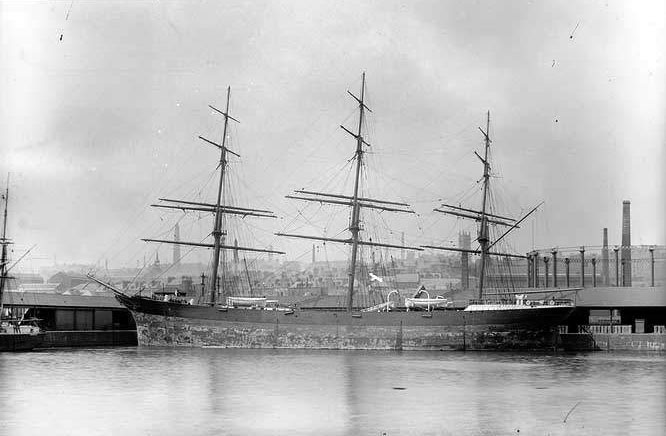
A three-masted full-rigged sailing ship, the Maxwell was a cargo carrier built in her home port of Liverpool in 1887. After arriving from San Diego on August 21, 1894, the Maxwell’s ballast was unloaded, and the ship beached for a hull cleaning, leaving its crew with plenty of time ashore to play a game of soccer. The match report observed, “The sailors played splendidly, and with a little practice would have given the local men a hard call.” The report also noted the Maxwell’s captain “was kind enough to stay on board the ship” so his first and second officers could “be present at the game,” although it is unclear if they played. To give a sense of the size of the crew compared to the “over 400” aboard the Teutonic, the Maxwell had a crew of twenty-six when she sank on April 1, 1902, after a collision with the steamer Patagonia off Dungeness on her return from San Francisco.[5]
Matches by US clubs on the West Coast against a team from a single British ship were rare. One exception occurred on November 19, 1898, when San Francisco’s Vampires drew 2-2 with the crew of the Moana, a match that is perhaps the closest on the West Coast to the kind of matches that regularly occurred on the East Coast. The Moana was a cargo liner that could carry about 300 passengers in first- and second-class berths. Built in Dumbarton, Scotland in 1897 and owned by the Union Steam Ship Company of New Zealand, the Moana had a crew of 109. Even with that more sizable crew, the Vampires needed to loan players to the sailor team to play a nine-a-side game.[6] Ship crew-based opposition was familiar to the Vampires. With few local sides in existence to play, the Vampires faced “Mercantile Marine” sides made up of players from ships in port three times in 1898, winning each game.[7]
Mercantile Marine sides in San Francisco were organized by the Seamen’s Institute, which had a presence in ports around the world.[8] The San Francisco Call described the Seamen’s Institute as a place “where the sailor far from home can go and enjoy himself without the aid of firewater,” adding, “All are welcome, no distinction being made as to a man’s color or race.”[9] Twenty-two matches in San Francisco between 1898 and 1905 involving Seamen’s Institute organized teams have been identified, fifteen of which were against the Vampires. Seamen’s Institute matches against local sides during the Christmas and New Year’s holidays became something of an annual tradition. The California Association Football League was formed in 1902. By 1903 Seamen’s Institute sides were providing what were essentially practice matches for league clubs or new teams finding their footing in the local soccer scene with matches against the Oakland Hornets, East Oakland Pirates, and Oakland’s Albion Rovers reported in the press. Often, Seamen’s Institute teams lost these games, sometimes badly. This was understandable considering no Seamen’s Institute roster was stable, “the players depending upon the number of sailors and middies in port at the time.”[10] However, echoing early events in New York and Northern New Jersey, Seamen’s Institute players also joined local sides, as in the case of the San Francisco team in 1903, or filled out short-handed local sides, as with the Pickwicks in 1904.[11] Nevertheless, the enduring presence of Seamen’s Institute teams in the San Francisco Bay soccer scene was recognized and respected and Seamen’s Institute delegates attended the annual meeting of the California Association Football Union in September 1905.[12]
In October 1901, a match was played in Portland, Oregon against the crew of the sailing ship Cleomene. A preview of the match against the Liverpool-based ship described it as “the first match of association football that has been arranged in Portland in several years.” The report explained that while soccer “was quite popular in North Portland half a dozen years ago…the intercollegiate game has quite displaced it.”[13] Soccer’s fall from favor in Portland was so profound that another preview carefully explained how the game was played so spectators would be able to understand what was happening on the field.[14] The Cleomenes won 2-1 at the Bishop Scott Academy grounds on October 26, defeating an aggregation put together by the Portland Seamen’s Institute from other ships in port. In goal for the Cleomenes was the captain of the ship and one of the “stars” of the team reportedly “was recently a member of a famous Liverpool team.”[15] The match report concluded, “Both teams had tea afterward.”[16]
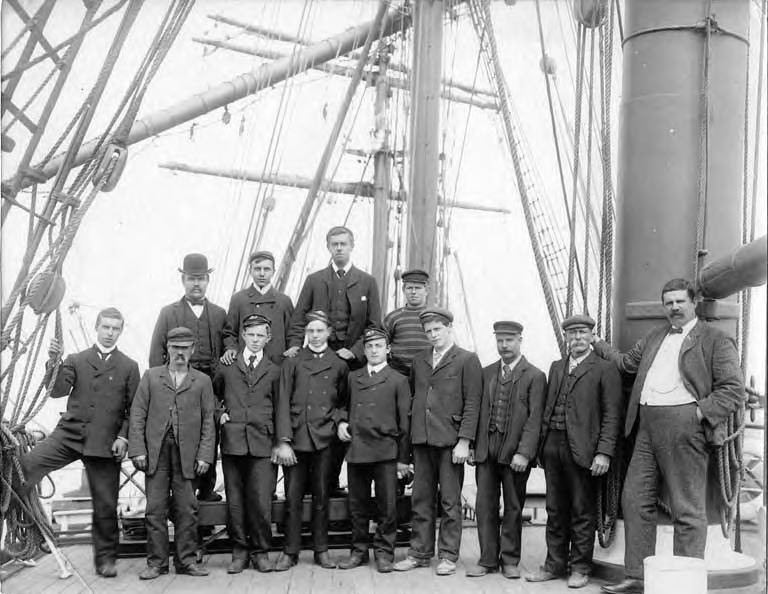
The Cleomenes enjoyed the match so much that they issued a challenge to “any association football team that Portland can produce.” The problem was that no Portland-based team then currently existed. But the report on the Cleomenes challenge included encouraging news: “An association football team representing the City of Portland will probably be formed this week, and as nearly all the officers and crews of British ships visiting this port play association football, a series of matches will be arranged.”[17] The Cleomenes were defeated 5-0 by a Portland Seamen’s Institute side that appears to have been a mix of local and ship-crew players on November 2. In December, soccer “was placed on a firm basis” in Portland with the formation of the Portland Football Club, who defeated a Seaman’s Institute side 2-0 in its first game on December 21, 1901. On Christmas Day, Portland played a team selected from the crews of British ships in port to a 2-2 draw, before defeating another Seamen’s Institute side 4-0 on January 1, 1902. The start of the New Year’s Day match was delayed nearly an hour because “the sailors were kept at work on their ships until the last minute.” [18] From its founding through 1905, Portland FC played various British ships-in-port sides thirteen times. As Portland soccer historian Zachary B. Bigalke has concluded, “The Seamen’s Institute was the catalyst for the rebirth of soccer in Portland in the first decade of the twentieth century.”[19]
As was the case on the East Coast, matches against teams from British ships were viewed in Portland as good tests ahead of tournament play. When the Portland team twice defeated a combined team made up of crewman from the British steamers Comeric and Tottenham in August 1905, one report concluded, “the Portland team should have a distinct look-in for the Pacific Coast championship” to be staged during the Lewis and Clark Centennial Exposition a month later. When the tournament was announced it was hoped teams from California, Oregon, and Washington would be joined by clubs from British Columbia in championship competition: “Never was there a better chance along the Pacific Coast to boom association football.”[20] In the end, one British Columbia team from Ladysmith was the only side to travel to the Exposition. There the Canadians defeated the Portland side twice by the combined score of 10-1. In between, Ladysmith defeated a Portland Rovers side made up of players from Portland, South Bend and Ilwaco and “five sailors selected from British ships now in harbor.” The Rovers lost 4-0.[21]
Royal Navy crew matches in Hawaii
The earliest recorded soccer match in Hawaii took place on April 28, 1900. On that day, “Scotland” drew 0-0 with “The World.” By December 1, four clubs had been organized. The names of two of the teams, England and Scotland, reflected the national origins of their members. The formation of the Hawaiian Association Football League was soon announced, and the league commenced play in January 1901. An article published after league play began reported goal nets would not be available until the next season so linesman were reminded of their obligation to notify the referee if the ball crossed the goal line: “Many a goal has been scored after the ball has crossed the goal line, and been brought again into play.” Two nonleague workplace teams also organized.[22] Before the start of league play, a “Honolulu” team played three matches against teams from British merchant ships in port that helped further grow interest in soccer. At the end of December more competition arrived in the form of the team from the Royal Navy sloop of war Icarus.
Assigned to the Royal Navy’s Pacific Station based at the Esquimalt Royal Navy Dockyard in British Columbia, HMS Icarus had a crew of 200.[23] One report described, “The Icarus has a sturdy team, who next to the Warspite’s doughty heroes are champions of the Pacific,” adding, “Honolulu men will now have an opportunity of testing their quality against a tried team, and the encounter should add much to their knowledge of the game.”[24] Three matches were played over a week against the Icarians at the Makiki Grounds. The local England team lost 4-2 on December 22 in front of “a large attendance of spectators, who were treated to a fine display of the dribbling game.”[25] The Scotland team lost 2-1 on Christmas Day, a match that “drew the largest crowd to Makiki that has yet attended the Association game.”[26] On December 29, a combined Honolulu team composed of players from the England and Scotland teams finally got a result, drawing 2-2 with the sailors in front of a “large crowd.”[27]
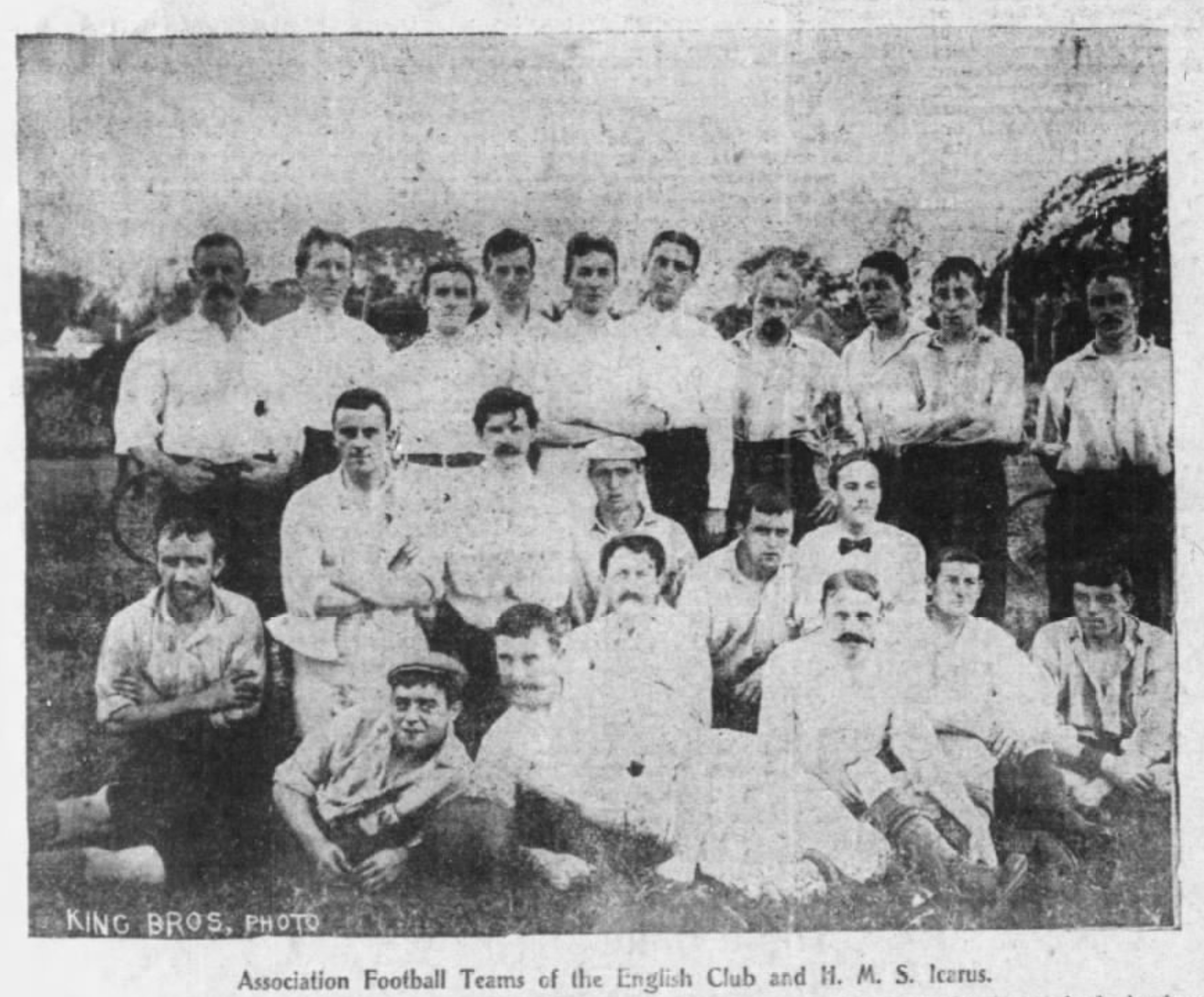
Honolulu’s soccer community eagerly awaited the visit of the armored cruiser HMS Warspite and the return of the Icarus in March 1901. Warspite was the flagship of the Pacific Station and had a crew of 535.[28] A report in February noted, “The Warspite footballers defeated the team of H.M.S. Icarus at the Association game and the latter, it will be remembered, carried too many guns for local teams.”[29] To prepare for the visit of the British warships, “the Association football season” was “indefinitely extended” to give “the local eleven” as many practice games as possible.[30] The practice paid off on March 18 when the combined Honolulu side, largely made up of players from the Scotland team, defeated the Warspites 3-0, although it was acknowledged the visitors were unable to field their strongest side because three of their best players were “on the other watch and therefore unable to get away.”[31] The next day, the Scotland team defeated the Warspites 5-0. After the match in the rooms of the Scottish Thistle Club, the Hawaiian Association Football League hosted a smoking concert in which players from the Warspite were the guests of honor: “Jolly goodfellowhip held full sway.”[32]
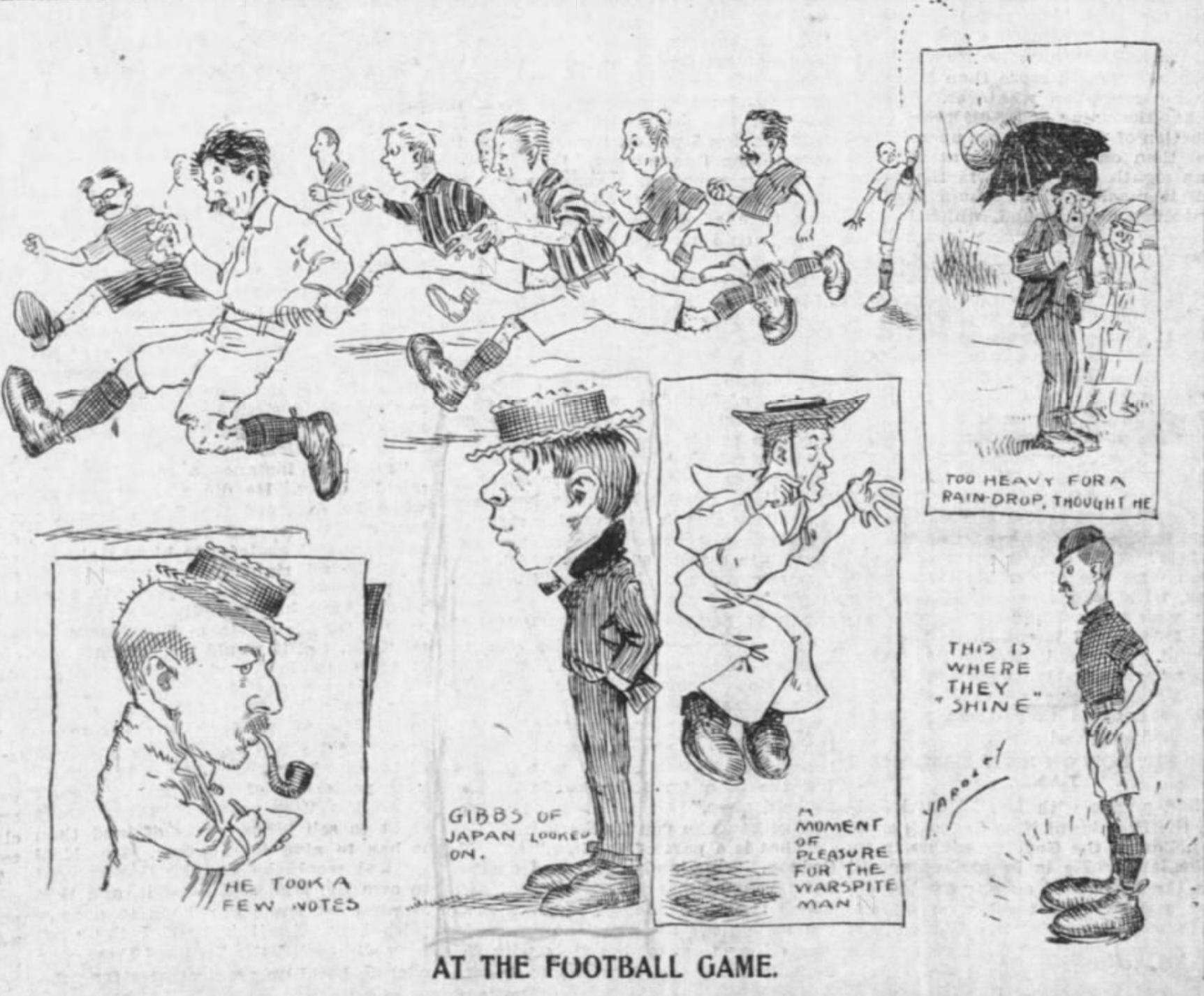
On March 27 the Icarus returned to Honolulu. Three games were played against local sides during its stay: a 3-1 loss to Scotland on March 30, a 7-0 loss to England on April 4, and in what was the last soccer game of the season, a 7-0 loss to an all-Hawaiian League side on April 6.[33] The decisive change in results compared to the ship’s previous visit was explained by the lack of practice on the part of the Icarians after a long patrol of the South Pacific and the fact that local sides had been able to benefit from continuous league play and practice games. The Icarians also said their side was weakened by the desertion of two of its best players.
The visits of Icarus and Warspite helped solidify the place of the Hawaiian Association Football League in the local sporting landscape in its founding season and allowed local clubs to test themselves beyond familiar local opponents. High profile visits by Royal Navy ships ensured positive newspaper coverage before and beyond the league’s first season and attracted the largest crowds yet seen at local soccer games. After the 1901 matches, Royal Navy teams were met by all-Hawaiian League sides; between 1902 and 1905 all-league sides played five matches against Royal Navy ships, recording two wins, two losses, and a draw. Teams from Royal Navy ships also played two matches in Honolulu amongst themselves. In 1903, All Honolulu sides also won two victories against the Silvertown, the cable-laying steamer then in the midst of establishing the first direct telegraph route from the US to the Philippines, China, and Japan.[34]
British ship crew matches in Texas
Ports on the East and West Coast and in Hawaii are obvious points of contact with soccer-playing British sailors. But busy ports are also found along the Gulf Coast. No reports have been found of British ship crew matches in New Orleans, Mobile, or Tampa through 1905 but matches in Galveston, Texas have been found. One history of the city observes, “Being the only deepwater port between New Orleans and Tampico, Mexico, Galveston supplied Texas and the western United States with essential goods that fueled development of the entire nation. By 1899, the town had become a bustling commercial center of wharves, cotton warehouses, banks and stores.”[35] The city’s place as a major port only grew following the reconstruction efforts in the aftermath of the devastating hurricane of 1900. Soccer was first organized in Galveston on Texas’ Gulf Coast in 1895. But aside from a report of a single game played by boys at a YMCA oyster roast in October 1895, soccer is absent from Galveston newspapers until 1904.[36] When it did reappear, it was in the form of exhibition games between teams made up of ships in port because no local sides then existed.
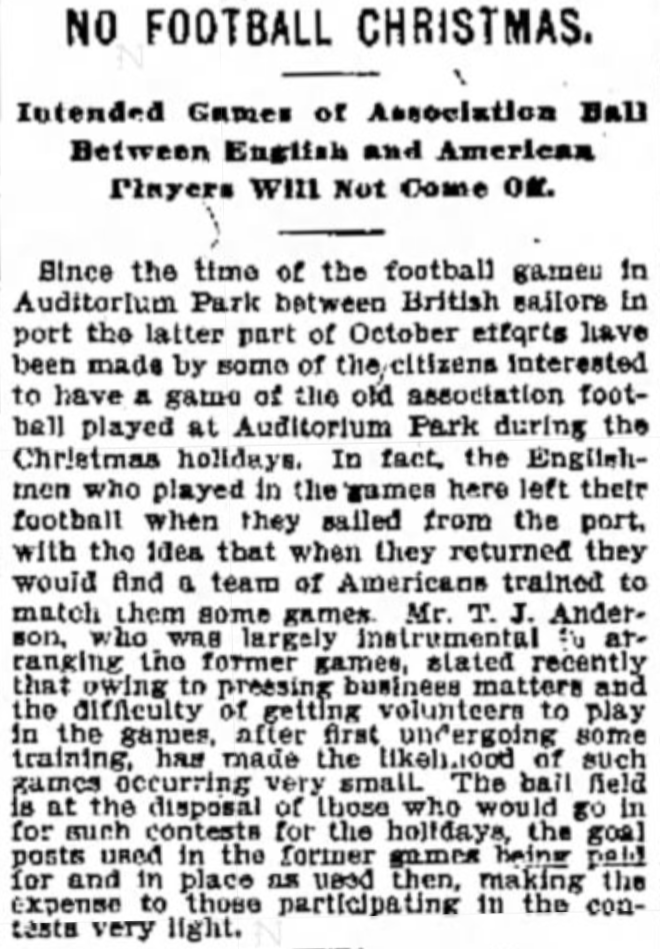
In November 1904, the Galveston Daily News reported the captain of the British steamship Burnholme, whose home port was in Whitby, England, had challenged “anyone present” at the Merchant Service Guild to a game. The captain of the steamship Cheviot Range accepted the challenge and said he would organize a team “chosen from among the Neptune steamship line’s vessels.” The match would be played at Galveston’s Auditorium Park with all proceeds from the game to be donated to a local charity. The match announcement included a review of the rules of soccer.[37] On November 20, the “Neptunes,” or “Captain Rea’s team,” faced the “Red Crosses,” or “Captain Brecken’s team.” The Neptunes were selected from the steamships Cheviot Range, Runo, Queen Wilhelmina, and Pennine Range. Sunderland, where the Neptune Steam Navigation Company had been founded in 1891, was the home port for each ship. The Red Crosses was composed of players from the Burnholme, Incharran, and Alston, with home ports of Whitby, Liverpool, and West Hartlepool, respectively. The Red Crosses finished 2-0 victors.[38] On November 24, Thanksgiving Day, a match between the Neptunes, now styled as the Neptune Rangers, was the main event of a day of athletic contests featuring sailors at Auditorium Park. The Neptune Rangers, with players from Cheviot Range, Runo, Queen Wilhelmina and the Liverpool-based Middleham Castle were 5-3 victors over the “Amots,” made up of players from the Burnholme, Glengoil (Leith), Carrigan Head (Belfast), and Breckfield (Liverpool).[39] It is unclear if the Merchant Service Guild was involved in organizing the matches.
After the Thanksgiving Day match, the various ships whose crewmen participated in the two exhibition matches sailed from port. One report noted, “In fact, the Englishmen who played in the games here left their football when they sailed from port, with the idea that when they returned they would find a team of Americans trained to match them in some games.” It was hoped a match could be organized during the Christmas holidays. But owing to “the difficulty of getting volunteers to play in the games, after first undergoing some training,” no local team was organized, even with “the goal posts used in the former games being paid for and in place as used then.”[40] Another soccer match was played on March 5 at Auditorium Park between the crews of the steamships Neptune and Incharran but there was little local interest: “Outside of the crews of a number of boats in port very few people were present.”[41]
Conclusion
The positive impact that visits by English or Scottish sides might have on soccer’s development in the United States was recognized before the 1905 visit by the English amateur team the Pilgrims. In fact, British teams had been playing against US club sides since at least 1890. On the East Coast, US clubs faced ocean liner-based club sides. These ocean liner teams provided valuable competitive matches for leading clubs preparing for American Cup tournament play. Two liner-based teams joined the American Football Association, one of which entered the American Cup tournament — then the closest thing to a national championship for the United States — and also tried to join the American Association Football League. Teams and players associated with British ocean liners also intersected with two of the earliest professional leagues in the US. Additionally, local sides recruited players from ocean liner clubs to strengthen their rosters for important matches. Later, clubs from ocean liners played matches against US clubs in Rhode Island and Massachusetts.
On the West Coast, teams organized by the Seamen’s Institute and selected from British merchant ships in port were instrumental in helping to support the establishment of some of the first clubs and leagues in San Francisco and Portland by providing regular match competition when few local sides existed. In Hawaii, matches against teams based on Royal Navy ships helped put that state’s first organized league on firm footing, ensuring — and extending — positive press coverage before and after the league’s founding season. In Texas, matches between teams selected from the crews of British merchant ships in port provided the earliest exhibitions of senior soccer ever played in Galveston, even if local residents were largely uninterested.
These British ship crew matches did not result in the kind of press coverage that accompanied the Pilgrims tour and it is likely that far more matches were played against British ship teams than were reported. We can make this conclusion based upon references to played matches for which no reports have been found. Still, it is remarkable that reports of matches between local sides and teams from British ships have not be found in some major port cities on the East Coast such as Philadelphia, where organized soccer was played beginning in 1889. Similarly on the West Coast, while a report from May 1894 describes Seattle FC had “the assistance of the sailors of the ship Astracana, now in port,” as the team practiced for a trip to British Columbia, no other reports involving ship-based teams in Seattle have been found between 1890 and 1905.[42] If New York and Northern New Jersey, why not Philadelphia? If San Francisco and Portland, why not Seattle? If Galveston, why not New Orleans?
Wherever they were played, matches against British ship teams were significant events in local soccer communities, whether in the established scenes on the East Coast or emerging scenes on the West Coast and in Hawaii, and their impact was felt long after memories of such matches faded. Coming in an era in which international play has typically been understood to mean play against Canadian sides, matches against ship crew teams between 1890 and 1905 demonstrate soccer in the US at the time was more internationally connected to British based teams than has been previously recognized.
Endnotes
[1] Zachary R. Bigalke, “Soccer in the Heart of Cascadia: Portland, Astoria, and the Growth of the Sport from 1890 to the Advent of World War,” in Soccer Frontiers: The Global Game in the United States 1863-1913, ed. Chris Bolsmann and George Kioussis (Knoxville: The University of Tennessee Press, 2021), 211.
[2] “Ships’ Crews Will Play, Morning Oregonian, Dec. 9, 1905, 7; “Play Association Football,” Sunday Oregonian, Dec. 10, 1905, Part 2, 16.
[3] “Soccer in the Heart of Cascadia,” 204.
[4] “Soccer in the Heart of Cascadia,” 209.
[5] “About Town,” Daily Astorian, Aug. 22, 1894, 4; “About Town,” Daily Astorian, Aug. 24, 1894, 4; “About Town,” Daily Astorian, Aug. 31, 1894, 4. “Football Today,” Daily Astorian, Aug. 25, 1894, 4; “About Town,” Daily Astorian, Aug. 26, 1894, 4; “The Loss of the Maxwell,” Liverpool Daily Post, Apr. 3, 1902, 6.
[6] “Association Football,” San Francisco Call, Nov. 20, 1898, 10; “Ship Fact Sheet: Moana (1897),” P & O Heritage. Accessed Jun. 5, 2022. https://www.poheritage.com/Upload/Mimsy/Media/factsheet/93801MOANA-1897pdf.pdf
[7] “Sailors Beaten by Lusty Vampires,” San Francisco Examiner, Jan. 23, 1898, 34; “Sailors Outclassed by the Vampires,” San Francisco Chronicle, Nov. 13, 1898, 23; “Vampires Win from Mercantile Mariners,” San Francisco Chronicle,” Dec. 18, 1898, 23.
[8] “Association Football,” San Francisco Chronicle,” Oct. 28, 1899, 8; “Association Football,” San Francisco Chronicle, Nov. 4, 1899, 8.
[9] “Sailors Enjoy an ‘At Home,’” San Francisco Call, Dec. 10, 1903, 12.
[10] “Association Game Growing in Favor,” San Francisco Chronicle, Dec. 27, 1903, 34.
[11] “Football Men Gain Recruits,” San Francisco Call, Feb. 7, 1903, 10.
[12] “Association Footballists Will Convene Saturday,” San Francisco Examiner, Sep. 14, 1905, 10; Sodden Ground Spoils Sport,” San Francisco Call, Jan. 18, 1904, 11.
[13] “Association Football,” Morning Oregonian, Oct. 24, 1901, 7.
[14] “Association Football,” Morning Oregonian, Oct. 26, 1901, 8.
[15] “Jack Tars and Football,” Morning Oregonian, Oct. 25, 1901, 7.
[16] “Sailors Win 2 to 1,” Sunday Oregonian, Oct. 27, 1901, 24.
[17] “Cleomenes Challenge,” Morning Oregonian, Oct. 28, 1901, 5.
[18] “Football Club Organized,” Morning Oregonian, Dec. 18, 1901, 5; “Lively Game of Rugby Football,” Sunday Oregonian, Dec. 22, 1901, 11; “Scored Two Goals Each,” Morning Oregonian, Dec. 26, 1901, 8; “Sailors Couldn’t Score,” Morning Oregonian, Jan. 2, 1902, 3.
[19] “Soccer in the Heart of Cascadia,” 211.
[20] “To Boon Football,” Sunday Oregonian, Apr. 23, 1905, part 2, 17.
[21] “Ladysmith Wins Game,” Morning Oregonian, Sep. 29, 1905, 7; “Ladysmith Takes Cup,” Sunday Oregonian, Oct. 1, 1905, part 2, 16 ; “Visitors Win Again,” Morning Oregonian, Sep. 30, 1905, 7.
[22] “Two Ciphers,” Pacific Commercial Advertiser: Honolulu, Apr. 30, 1900, 12; “Association Football, Pacific Commercial Advertiser: Honolulu, Dec. 1, 1900, 9; “The Association Game at Punahou, Pacific Commercial Advertiser: Honolulu, Dec. 15, 1900, 5; “Association Football at Makiki This Afternoon For the Championship of Honolulu,” Pacific Commercial Advertiser: Honolulu, Jan. 5,1901, 12; “Game at Makiki,” Pacific Commercial Advertiser: Honolulu, Dec. 8, 1900, 15.
[23] Icarus crew number figure from “British Warship in Port,” San Francisco Examiner, Feb. 26, 1900, 5.
[24] “Association Football,” The Independent (Honolulu), Dec. 22, 1900, 2
[25] “Sailors Beat Landlubbers,” Pacific Commercial Advertiser: Honolulu, Dec. 24, 1900, 12.
[26] “Tars Will Play Town,” Pacific Commercial Advertiser: Honolulu, Dec. 29, 1900, 14.
[27] “A Tai Game,” Evening Bulletin (Honolulu), Dec. 31, 1900, 1.
[28] “Warspite is a Flagship,” Honolulu Republican, Mar. 15, 1901, 3.
[29] “Gossip of Sport,” Pacific Commercial Advertiser: Honolulu, Feb. 22, 1902, 12.
[30] “Will Play More Football Games,” Pacific Commercial Advertiser: Honolulu, Mar. 9, 1901, 13.
[31] “Cityites Win,” Pacific Commercial Advertiser: Honolulu, Mar. 19, 1901, 6.
[32] “Poor Old Ship,” Pacific Commercial Advertiser: Honolulu, Mar. 20, 1901, 1-2; “Good Fellowship Reigned Supreme,” Honolulu Republican, Mar. 21, 1901, 5.
[33] “Icarus Returns,” Hawaiian Star, Mar. 27, 1901, 1; “Turns Tables This Time,” Pacific Commercial Advertiser: Honolulu, Apr. 1, 1901, 11; “Limejuicers Beat Icarians,” Pacific Commercial Advertiser: Honolulu, Apr. 5, 1901, 5; “League Wins the Final Game,” Pacific Commercial Advertiser: Honolulu, Apr. 8, 1901, 14.
[34] “Sailors Defeated by Local Players,” Evening Bulletin (Honolulu), Feb. 23, 1892, 8; “Shearwater Men Beaten,” Evening Bulletin (Honolulu), Dec. 8, 1902, 5; “Amphitrite Jackies Win at Football,” Pacific Commercial Advertiser: Honolulu, Apr. 25, 1903, 1, 5; “Lads from Amphitrite Winners,” Pacific Commercial Advertiser: Honolulu, May 1, 1903, 9; “Clean and Pretty Game,” Pacific Commercial Advertiser: Honolulu, May 3, 1903, 7; “Jackies in a Great Ball Game,” Pacific Commercial Advertiser: Honolulu, May 5, 1903, 5; “Amphitrites Win Again,” Evening Bulletin (Honolulu), May 7, 1903, 6; “Hot Football Ends in Draw,” Evening Bulletin (Honolulu), Mar. 18, 1905, 5; “Good Football Game,” Evening Bulletin (Honolulu), Jan. 12, 1903, 2; Honolulu Boys Beat Silvertown,” Pacific Commercial Advertiser: Honolulu, Jan. 23, 1903, 9.
[35] Jody Wright-Gidley and Jennifer Marines, Galveston: A City on Stilts (Charleston, SC: Arcadia Publishing, 2008), 11.
[36] “Amateur Athletics,” Galveston Daily News, Oct. 1, 1895, 8; Boys’ Oyster Roast, Galveston Daily News, Oct. 27, 1895, 4. A soccer game between boys was also reported in Austin that December: “Another Victory,” Austin American Statesman, Dec. 13, 1895, 3.
[37] “Football Today,” Galveston Daily News, Nov. 20, 1904, 4.
[38] “The Football Game,” Galveston Daily News, Nov. 21, 1904, 7.
[39] “The Football Contest,” Galveston Daily News, Nov. 24, 1904, 5; “Sailors Make Sport,” Galveston Daily News, Nov. 25, 1904, 6.
[40] “No Football Christmas,” Galveston Daily News, Dec. 20, 1904, 4.
[41] “Yesterday’s Football Game,” Galveston Daily News, Mar. 6, 1905, 7. Lloyd’s Register of British and Foreign Shipping for 1905 lists sixteen ships with the name Neptune. It is unclear which Neptune participated in the match. Lloyd’s Register of British and Foreign Shipping, 1905-06, Volume I – Steamers (London: The Society’s Printing House, 1905).
[42] “Getting Ready to Play at Victoria,” Seattle Post Intelligencer, May. 14, 1894, 3.

Pingback: Sailor lads, jolly tars, and rovers of the briny deep: International ship-crew soccer matches in the US, 1890-1905, part 2 – Society for American Soccer History